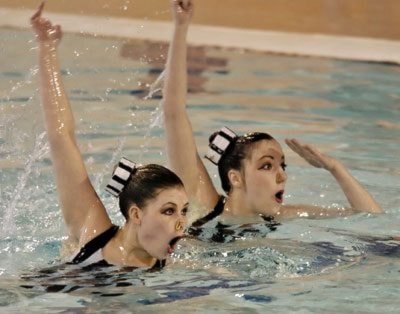Slicked back with gelatinous goop, the synchronized swimmers had alien hair.
“It’s gelatin,” said Quebec swimmer Alice Rijer, giving her rock-solid tresses a slap before the start of Thursday’s Canada Winter Games synchronized swimming duets.
“And it’s hard to get out, especially if the showers aren’t hot enough.”
After mixing up the powder in hot water, swimmers lather it on and wait 10 minutes until it dries.
The gelatin stays hard in the cold water, and is used instead of bathing caps to keep hair out of the swimmers’ faces.
Bathing caps are ugly, said Rijer.
“It’s an aesthetic thing.”
With garish eye shadow reaching right to their eyebrows, crimson lipstick and sparkly, sequined swimsuits, the athletes looked like aquatic figure skaters.
And the sports are actually quite similar, with competitors in both disciplines working together on themed routines that are judged on technical proficiency and artistic interpretation.
Dressed in striped ‘prison’ swimsuits, with tiny matching caps pinned to their rigid hair, the Yukon’s duet team was playing cops and robbers.
“It’s a jailbird theme,” said coach Aura-Lea Harper, who got the idea from a team she’d seen in 2003.
The Yukon girls were half-an-hour away from the finals, and were trying to remain calm.
“I just try and keep positive and motivate myself,” said Kelsey Metropolit.
“I’m nervous and excited,” added Christine Spinks.
The local girls were competing in the A duets, against some of the country’s best young swimmers.
Most provinces have two duet teams at the Games, and the best team from each province qualifies for the A finals.
However, because the Yukon only has two swimmers, they were placed in the A finals automatically.
“Last year they were competing in tier two, and this is tier seven,” said Harper.
“That’s a big jump.”
Harper had to beg her two Yukon girls to continue this year, so they could go to the Games, she said.
Watching some stiff competition from the sidelines, the swimmers couldn’t stop moving under their towels.
“You have to keep shaking and moving so your muscles don’t get cold,” said Quebec swimmer Camille Bowness.
“And it’s harder here because there’s no pool to warm up in.”
On high lifeguard chairs, judges watched as kicking and twirling feet erupted from the pool’s smooth surface, followed, eventually, by arms and torsos.
Moving to music, the swimmers gulped air before disappearing again, sometimes holding their breath for more than a minute while their legs danced.
But holding your breath isn’t the hard part, said former Olympian Jessica Chase.
Chase, who earned Canada a bronze medal for synch swimming in Sydney, Australia, knows the sport is trickier than it looks.
It’s an artistic, graceful sport and people get distracted by the beauty of it and forget it’s difficult and extremely taxing, she said.
To stay synchronized, athletes need to fine-tune their motor skills. Throw in speed, power, endurance, strength, flexibility and a pool full of water and it gets difficult.
“It’s multi-faceted and involves extensive training,” said Chase.
“It’s like the difference between doing jumping jacks and doing jumping jacks while holding your breath in a foreign medium.”
Lactic acid starts to build up in the muscles about three minutes into the four-minute routine, said Newfoundland swimmer Kim Burrage.
“And it makes you feel really exhausted.”
Burrage was tossed into synchronized swimming by her mom when she was 11.
But she didn’t have to brave it alone. Mom also tossed in Burrage’s twin sister Sarah.
With matching pink and blue iPods strapped to their biceps, the identical twins were awaiting their turn at a medal.
“We wanted to go into aqua-jazz,” said Kim.
“But my mom saw a (synchronized swimming) duet on TV — she’s into all that stuff, like figure skating.”
Being twins in a synchronized event draws quite a bit of attention to the Burrage girls.
“We go to school together, we train together, we have the same friends,” said Sarah.
“But not the same boyfriend,” she added with a laugh.
“When we’re swimming, it’s the only time our mom can’t tell us apart,” said Kim.
To succeed as a duet, the partners have to be close.
If you’re not already good friends, you become good friends, said Metropolit.
Many of the teams practise more than 20 hours a week, and end up spending more time with each other than anyone else.
Thursday’s competition ended with a fast, technical and very graceful gold-medal swim by Quebec duet team Bowness and Marie-Lou Morin.
“It helps that we look similar,” said Bowness.
“And our routine is fast and there’s a number of movements.”
The pair has been swimming together for three years and is eyeing the Olympics.
“But we’re taking it one step at a time,” said Morin.
The Yukon team didn’t medal, but was happy with the experience.
“They worked hard and I’m proud of them,” said Spinks’ mom Janet.
“Chrissy came home from school one day and said she wanted to be a synchronized swimmer, and she went that night and hasn’t stopped.”
Harper knew the girls wouldn’t be in the medal round.
“I just wanted them to do the best they could,” she said.
“And they did.”
Silver went to Ontario’s Katie LePage and Chelsey Matthews.
“We went into it third,” said LePage.
“So we’re happy.”
Alberta’s Emily Brooks and Claire Friesen earned bronze.
In the B duets the provincial lineup followed suit.
Quebec’s Jo-Annie Fortin and Stephanie Leclair got gold. Silver went to Ontario’s Alyssa Bezeau and Stephanie Saunders, and Alberta’s Nicola Allen and Savannah Forrester took bronze.
